The 45-Second Trick For News Articles
The 45-Second Trick For News Articles
Blog Article
The Best Guide To News Articles
Table of ContentsHow News Articles can Save You Time, Stress, and Money.All about News ArticlesSome Known Details About News Articles The 25-Second Trick For News ArticlesNot known Factual Statements About News Articles
Great understanding of different subjects offers trainees a competitive side over their peers. Even though digital and social networks are easily available, we should not fail to remember how crucial it is to check out the papers. Parents need to try and instill the practice of reviewing a newspaper as an everyday routine to proceed the tradition of the adored print tool.Newspaper article likewise have at least among the following vital qualities loved one to the intended audience: closeness, prominence, timeliness, human rate of interest, curiosity, or consequence. The relevant term journalese is in some cases utilized, generally pejoratively, to refer to news-style writing. Another is headlinese. Papers generally stick to an expository writing design.
Within these limits, newspaper article also aim to be detailed. Other aspects are included, some stylistic and some obtained from the media form. Among the larger and more revered papers, justness and equilibrium is a significant consider offering details. Commentary is generally restricted to a different section, though each paper may have a different total slant.
Newspapers with a global audience, for instance, have a tendency to use a more official design of creating. The details options made by a news electrical outlet's editor or content board are typically accumulated in a style guide; typical style overviews consist of the and the US Information Style Book. The major goals of news writing can be summarized by the ABCs of journalism: accuracy, brevity, and clearness.
News Articles for Dummies
As a rule, journalists will not utilize a long word when a brief one will do. They use subject-verb-object building and vivid, active prose (see Grammar). They use stories, instances and metaphors, and they hardly ever depend upon generalizations or abstract concepts. Information writers try to prevent making use of the very same word more than when in a paragraph (occasionally called an "resemble" or "word mirror").
However, headings sometimes omit the subject (e.g., "Leaps From Watercraft, Catches in Wheel") or verb (e.g., "Pet cat lady lucky"). A subhead (likewise subhed, sub-headline, subheading, subtitle, deck or dek) can be either a subordinate title under the main heading, or the heading of a subsection of the article. It is a heading that precedes the major message, or a group of paragraphs of the main text.
Added billboards of any of these kinds may appear later on in the short article (particularly on subsequent web pages) to lure further analysis. Such signboards are additionally used as reminders to the post in various other areas of the publication or website, or as advertisements for the item in various other magazine or websites. Common framework with title, lead paragraph (summary in bold), other paragraphs (information) and contact details.

Example of a hard-lead paragraph NASA is recommending one more space task. The spending plan demands approximately $10 billion for the job.
An "off-lead" is the 2nd most essential front web page news of the day. To "hide the lead" is to start the write-up with background information or information of secondary importance to the visitors, forcing them to check out even more deeply into an article than they must have to in order to discover the important points.
The Facts About News Articles Uncovered
Usual use is that one or more sentences each create their own paragraph. Journalists normally define the organization or structure of an information tale as an upside down pyramid. The necessary and most fascinating aspects of a tale are placed at the start, with supporting details adhering to in order of diminishing significance.
It enables individuals to check out a subject to just the depth that their interest takes them, and without the charge of details or nuances that they could consider irrelevant, however still making that details readily available to extra interested viewers. The upside down pyramid framework additionally makes it possible for write-ups to be cut to any kind of arbitrary length during layout, to fit in the space offered.
Some writers begin their stories with the "1-2-3 lead", yet there are several kinds of lead available. A kicker can refer to multiple points: The last tale in the information broadcast; a "happy" tale to end the show.
Longer short articles, such as try this web-site publication cover short articles and the pieces that lead the inside sections of a paper, are called. Feature tales vary from straight information in several means. Foremost is the absence of a straight-news lead, the majority of the time. Rather than offering the significance of a story in advance, function writers might attempt to lure viewers in.
An Unbiased View of News Articles
A function's very first paragraphs commonly connect an interesting moment or event, as in an "anecdotal lead". From the details of a person or episode, its view rapidly expands to generalities regarding the tale's subject.

The Editor's Toolbox: A Referral Guide for Beginners and Professionals (2001) Allan M. Siegal and William G. Connolly. The New York Times Guidebook of Style and Use: The Official Style Guide Made Use Of by the Writers and Editors of the World's Most Reliable Newspaper (2002) M. L. Stein, Susan Paterno, and R.
Report this page